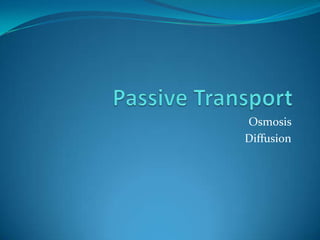
Passive transport
- 2. Passive Transport What was the job of the cell membrane? Help organisms maintain homeostasis by controlling what substances move into or out of the cell (semi-permeability). Some substances can move across the membrane without the cell having to expended energy This is known as Passive Transport (no energy required).
- 3. Diffusion Molecules of any substance are in constant random movement in all fluids. This movement is called Brownian movement. The NET movement of molecules from an area of higher concentration to an area of lower concentration is diffusion. The difference in concentrations of molecules across a space is called a concentration gradient.
- 4. Equilibrium Diffusion will eventually cause the concentration of molecules to be the same throughout the space that the molecules occupy. Equilibrium exists when the concentration of molecules is the same throughout a space.
- 5. Osmosis The process by which water molecules diffuse across a cell membrane from an area of higher concentration to an area of lower concentration is called osmosis. Water moves down its concentration gradient. It does NOT require energy to move down gradient, so it is a passive transport. Osmosis is the diffusion of water!!!!
- 6. What happened with the potato? Water moved (osmosis)INTO the potato cells placed in distilled water. Water moved (osmosis) OUT of the potato cells placed in salt water. WHY????????????? Concentration of water outside the potato cells in distilled water was HIGHer so it moved INTO the cells where the concentration of water was LOWer. Concentration of water inside the potato cells in salt water was HIGHer so it moved OUT of the cells where the concentration of water was LOWer.
- 7. Direction of Osmosis The direction of osmosis depends on the concentration of solutes on the two sides of the cell membrane. We have to compare the solution inside the cell to the solution outside the cell to determine where the molecules will go. Remember: The cell membrane is selectively permeable (semi-permeable) and water can always cross from areas of high concentration to areas of low concentration but some other molecules cannot. If the other molecules can’t cross then water will be the only molecule to move.
- 8. Types of Solutions: Compare solutes inside and outside cells. Hypotonic – Concentration of solutes outside the cell are lower than inside the cell. Isotonic – concentration of solutes outside the cell are equal to inside the cell. Hypertonic – concentration of solutes outside the cell are higher than inside the cell. How would the concentration of water molecules compare to the concentration of solute molecules? TIP: concentration of water is opposite that of solutes. If solutes are high then water is low, if solutes are low then water is high. Water diffuses from hypotonic solutions to hypertonic solutions.
- 10. How cells deal with osmosis Which environment do you think is easiest for cells to deal with? Is it the same for plant and animal? Isotonic: this is the case with the cells of most vertebrate animals on land and of most other organisms living in the sea. Many cells function in a hypotonic environment like freshwater unicellular organisms. Water constantly diffuses INTO these organisms. The organisms must rid themselves of the extra water that enters through osmosis. How?
- 11. Contractile Vacuoles http://www.youtube.com/watch?v=iG6Dd3COug4 Paramecium collects excess water into a vacuole that contracts expelling the water (sends it back out of the cell). Are contractile vacuoles a form of passive transport? NO: It requires energy from the cell to contract. Can you think of another way organisms living in a hypotonic environment could deal with this problem? Pump solutes out to keep the solutions inside the cell isotonic to those outside the cell making is less likely water will diffuse into the cell. This also requires energy. What term describes transport that requires energy? Active transport What happens to cells that can’t compensate for osmosis? Cytolysis (bursting of cells) or shrivel (shrink)
- 12. What type of environment is best for plant cells? Hypotonic: water moves into the plant cells by osmosis. (What do plant cells need water for?) Plant cells swell as they fill with water (stored where?) The swelling stops when the cell membrane is pressed up against the cell wall. The cell wall is strong enough to resist the pressure exerted by the water inside the expanding cell. (What would happen to an animal cell? Why?) The pressure that water molecules exert against the cell wall is called Turgor Pressure (TP). High TP is good!
- 13. What happens to plant cells in a hypertonic environment? Water leaves the cells through osmosis. The cell membrane shrinks away from the cell wall. Turgor Pressure is lost resulting in Plasmolysis Plasmolysis is the reason plants wilt if they don’t get enough water.
- 14. Facilitated Diffusion Process used for molecules that cannot diffuse rapidly through cell membrane even when there is a concentration gradient. Molecules could be insoluble in lipids or too large to pass through pores in the membrane. Any solutions? Ideas? Phospholipids and what? Movement of these molecules is assisted by carrier proteins. Acts as a door specific to certain molecules and only allows passage from HIGH concentration to LOW con. Glucose gets in and out this way. Why would that be important?
- 15. Diffusion through Ion Channels How does this work? Does it require energy? Why? Ions are not soluble in lipids. Proteins act as ion channels and are specific to each. Some are always open, others have “gates” that open and close to allow or stop ions (Calcium, Sodium, Potassium, Chloride). Gates will open or close in response to 3 kids of stimuli: stretching of membrane, electrical signals, or chemicals. What controls the gates? Stimuli!